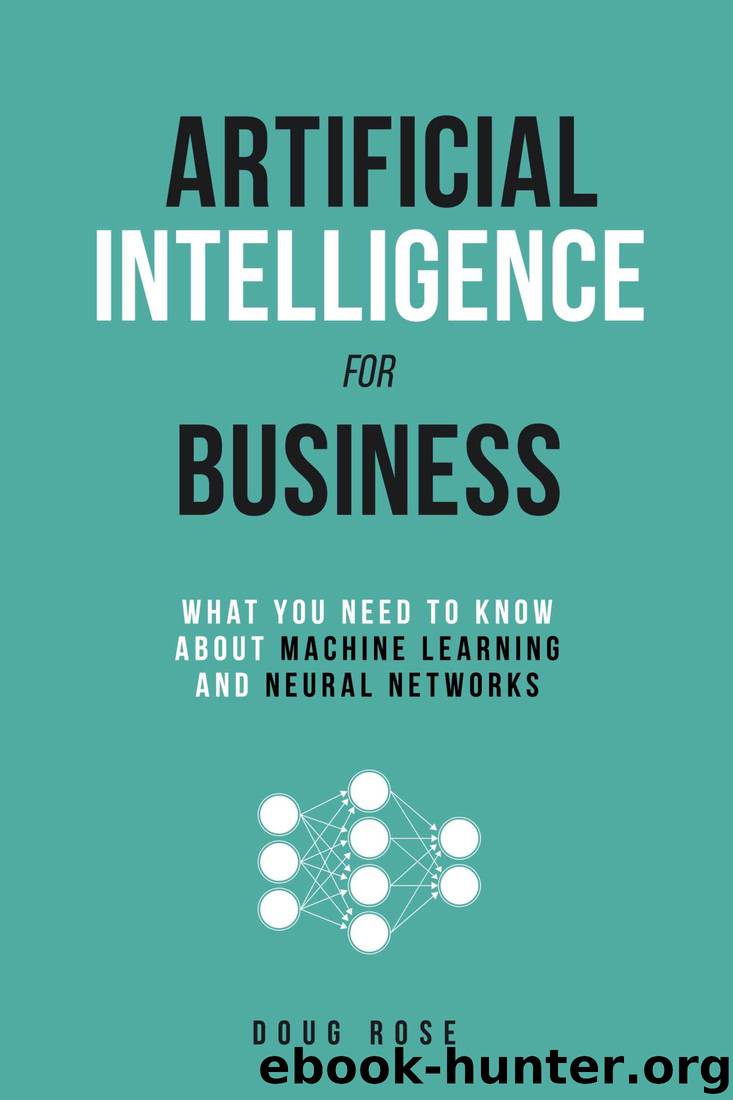Artificial Intelligence for Business: What You Need to Know about Machine Learning and Neural Networks by Doug Rose

Author:Doug Rose [Rose, Doug]
Language: eng
Format: azw3
Publisher: Chicago Lakeshore Press
Published: 2018-05-04T16:00:00+00:00
You can create a table or spreadsheet of this data with a column for each variable — drive time, weather conditions, traffic conditions, and time of day — and then enter data based on your drive to work over the past month. In machine learning, such a table is called labeled data, because all of the data is identified by name. This table and the data it contains serves as your training data. You feed this into the machine, and it identifies patterns; for example, if traffic is heavy, then your drive home may take an average of 30 minutes longer than when traffic is light. The computer may also find a connection between the time you left work and the amount of time it takes you to drive home.
The machine (computer) examines all the data and creates a model that can predict your drive time based on any combination of conditions — whether traffic is light, heavy, or normal; whether it's raining, sunny, or clear; and the time you left work. The model may be able to predict, based on the conditions you enter, what your drive time will be within 10 to 15 minutes of your actual drive time. That's pretty good, but you want a more precise answer.
Now you can feed test data into the machine. The test data was not shown to the machine while it learned from the training data. This test data represent a scenario that may not have been observed earlier. Ideally, we would want to exhaust all the possible combinations of independent variables to predict a dependent variable with certainty. However, as the number of independent variables increases and if these variables are numeric, there are infinite possible values these variables can take. Therefore, it is impossible to collect and utilize all the combinations of the training data. Without looking at the actual drive times, the machine uses the model it created to make its predictions. Internally, the model may work in different ways to predict the dependent variable of a test sample. It may simply fit the rules it learned during training, or try to linearly combine different independent variables, or combine them in mathematically complex and non-interpretable ways. The machine may also compare its predictions to the actual drive times. If its predictions aren't very accurate, then a practitioner might try to adjust the hyperparameters (try a different algorithm) and the machine tries again. The process may be repeated several times until the model generates predictions that are much closer to the actual drive times.
Supervised learning isn't much different from how you might learn something new, such as driving a car.
Download
This site does not store any files on its server. We only index and link to content provided by other sites. Please contact the content providers to delete copyright contents if any and email us, we'll remove relevant links or contents immediately.
Algorithms of the Intelligent Web by Haralambos Marmanis;Dmitry Babenko(8585)
Test-Driven Development with Java by Alan Mellor(7536)
Data Augmentation with Python by Duc Haba(7421)
Principles of Data Fabric by Sonia Mezzetta(7186)
Learn Blender Simulations the Right Way by Stephen Pearson(7112)
Microservices with Spring Boot 3 and Spring Cloud by Magnus Larsson(6930)
RPA Solution Architect's Handbook by Sachin Sahgal(6341)
Hadoop in Practice by Alex Holmes(6055)
The Infinite Retina by Robert Scoble Irena Cronin(6048)
Jquery UI in Action : Master the concepts Of Jquery UI: A Step By Step Approach by ANMOL GOYAL(5908)
Big Data Analysis with Python by Ivan Marin(5826)
Life 3.0: Being Human in the Age of Artificial Intelligence by Tegmark Max(5446)
Pretrain Vision and Large Language Models in Python by Emily Webber(4783)
Infrastructure as Code for Beginners by Russ McKendrick(4554)
WordPress Plugin Development Cookbook by Yannick Lefebvre(4266)
The Age of Surveillance Capitalism by Shoshana Zuboff(4189)
Functional Programming in JavaScript by Mantyla Dan(4165)
Embracing Microservices Design by Ovais Mehboob Ahmed Khan Nabil Siddiqui and Timothy Oleson(4053)
Applied Machine Learning for Healthcare and Life Sciences Using AWS by Ujjwal Ratan(4036)
